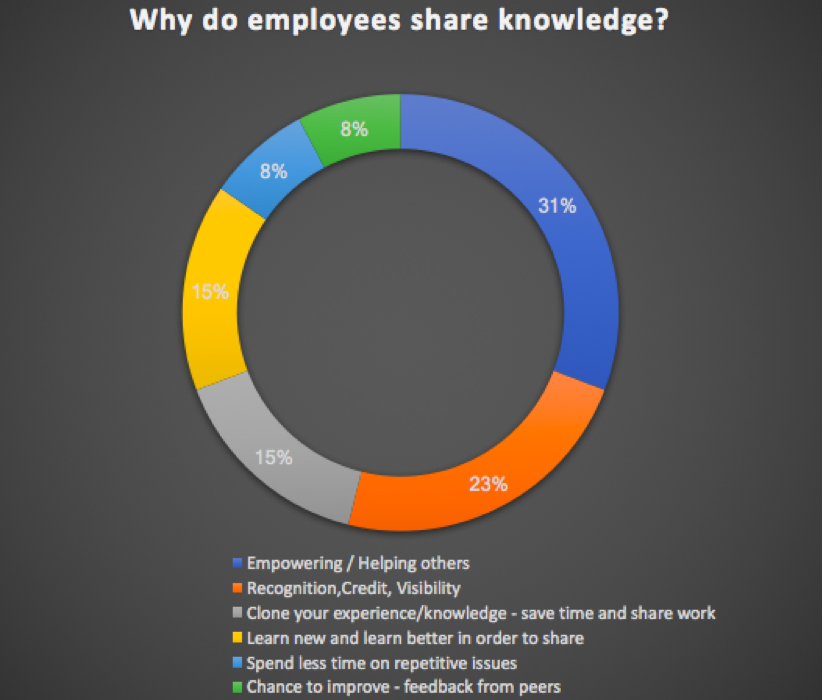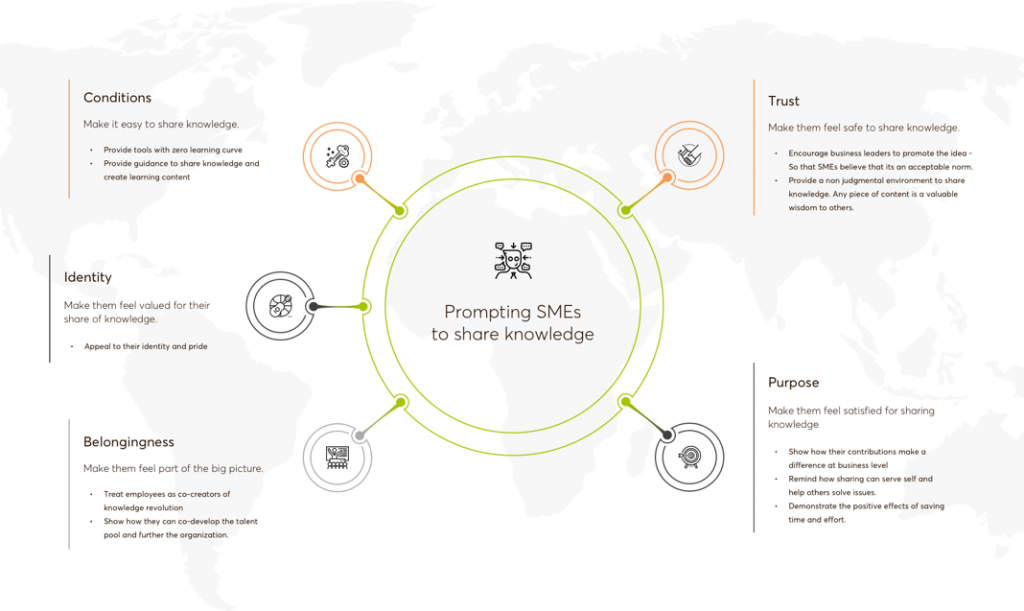Why Employee Engagement Matters
Today’s workforce is accustomed to personalized, on-demand training, in which on-the-job knowledge is always just a quick search away. Yet, learning environments and cultures at many organizations are failing to deliver this. In light of the generational shift currently taking place, the top-down culture that has dominated learning and development (L&D) for decades must now make room for a bottom-up approach. This is the only way today’s companies can keep up with the pace of change and continue to engage employees, a critical factor for business success.
So, how can HR departments effectively promote employee engagement when innovation and cultural shift is the name of the game? By ditching outdated, top-down employee engagement strategies, smart HR and L&D teams are already on the march toward a bottom-up engagement culture.
Here are some perspectives and action points that will help you and your colleagues as you consider making this switch yourselves.
Employee Engagement: HR and L&D Join Forces
A recent CascadeHR survey found that employee engagement is the top hurdle facing HR departments today. High employee engagement is a must, because it promotes retention of talent, fosters customer loyalty and improves organizational performance which adds value for all stakeholders.
How can HR facilitate a higher level of employee engagement? The key is to join forces with L&D to give employees greater responsibilities over their own career development.
Making employees responsible for their own career development is a highly effective way of boosting engagement. This responsibility promotes engagement because it makes employees feel valued for their efforts and trusted for their abilities.
There is a general trend toward handing over more responsibility to employees and managing their output. The same goes for learning and content creation. L&D must partner with employees and empower them to create content and share their knowledge. This model is referred to as employee-generated learning (EGL).
The EGL model is based on co-creation and knowledge-sharing. It triggers engagement since employees are instrumental in driving, voicing and bringing the flow of knowledge to life. When employees achieve recognition for their knowledge-sharing efforts, they gradually establish themselves as experts. This results in empowerment. Employees are empowered by contributing and making a difference inside their areas of expertise and responsibility.
Workforce development expert Julie Clow notes, “If employees have no sense of empowerment, they feel like victims in a gigantic, tragically unmovable system. Everyone gets trained, but absolutely nothing has changed.” That means it is vital for L&D to consider the bigger picture of employee engagement and empowerment when devising training strategies.
What’s in it for L&D?
According to L&D expert Jane Hart, knowledge-sharing is considered one of the most valuable learning methods, second only to on-the-job learning. From a pedagogical standpoint, knowledge-sharing enables deeper learning. Employees who share their knowledge must reflect, re-evaluate their thoughts and externalize them into information that others can consumer.
Knowledge-sharing also resonates with Bloom’s taxonomy levels, in which the highest level of learning is to create something based on the knowledge acquired. Creating learning content for others to use also allows employees to deepen their own knowledge and gain new insights in the process.
Why share knowledge?
In their academic study, Hsu and Wang identified multiple factors that drive knowledge-sharing behaviors in the workplace. These factors range from external drivers like future reward, status/respect and enhanced reputation, to intrinsic drivers like achieving a sense of self-worth, helping others and gaining a sense of belonging.
Similar to Hsu and Wang’s findings, we found that corporates that implement EGL and knowledge-sharing models observe the following drivers which encourage subject matter experts (SMEs) to share their knowledge:
- Satisfaction: By sharing their knowledge, SMEs experience a sense of satisfaction for helping others and making a difference to their peers. This satisfaction leads to finding a purpose and defining shared goals.
- Visibility: SMEs gain a confidence boost from being seen by others as an expert. It brings them a sense of pride and accomplishment.
- Time-savings: SMEs realize they are basically cloning their own wisdom. This extrinsic driver enables teams to work more efficiently and meet the speed of market and business, while spending less time repeatedly explaining things.
In addition to interviewing corporate leaders, we spoke with SMEs directly to gain an understanding of their motivations and concerns related to sharing knowledge. The findings were very consistent with the points listed above. The figure below shows motivators that drive knowledge-sharing.

Figure 1: Factors driving knowledge-sharing
Tips on activating knowledge-sharing behaviors
L&D should create a framework that allows employees to create content and share their knowledge. The subject matter experts (SMEs) create content, and L&D assists them in the process. This is consistent with one of the six priorities set by the eLearning Guild: “The L&D team does not have to create all the internal and external content itself, but it does need to oversee and monitor the process.”
Based on the research conducted by Hsu, Wang and Chao-Min as well as our own field observations, we illustrate five key tenets for prompting knowledge-sharing behaviors in SMEs – from making them willing to share knowledge, to making it technically possible to share their knowledge.

Best Practices
Drawing from the experiences of EGL practitioners, here are some best practices you can consider when implementing a knowledge-sharing model:
Effective Content Creation
L&D are responsible for providing the necessary technical infrastructure and support for sharing knowledge. They must be proactive in identifying opportunities for SMEs to share knowledge in a safe environment. We do not advocate replacing the entire conventional training suite all at once, but suggest looking for training on technical or tactical jobs where sharing knowledge is feasible.
There are two main ingredients to successful content creation:
1 – L&D must support SMEs in creating effective, pedagogically sound learning resources.
SMEs often assume that creating e-learning content too difficult because it involves developing complicated, full-fledged courses. L&D should make clear that learning content does not have to be a full course, but can be a simple how-to or best practice. Furthermore, L&D should provide the necessary resources and guidance on what constitutes good training material. A leading data measurement company supported its SMEs with a range of resources on how to create effective training content. This helped SMEs take on an informed role in knowledge-sharing.
2 – To share their knowledge, SMEs need an easy process and simple tools (zero learning curve and a great user interface).
Knowledge-sharing platforms and authoring tools must always address the needs of the SMEs. That means they must be easy and intuitive enough to use straight away without a heavy learning curve. If possible, guidance and coaching for creating more effective content should be embedded directly into the tools/platforms (i.e. smart support based on artificial intelligence).
Good is Good Enough
Traditionally, L&D professionals have strived to produce the most perfect learning experience possible. Is a perfectionist approach the best return on investment these days though?
Until recently, adding a video to a learning kit was considered an expensive option. Yet, this has now been completely disrupted by the explosion of low-cost media tools. YouTube, for instance, allows users to create videos from a mobile device, requiring no professional camera crew or actors. By now, media consumers have become very familiar with “less-than-perfect” production value in the user-generated content revolution. Production value and costs may have changed, but that doesn’t make the content less effective.
According to J.D. Dillon, the time has come to “eliminate the perfection mentality.” Instead of striving to achieve the perfect, most professional-looking training course, L&D teams should start giving SMEs everything they need to spring into action and do it themselves.
Appreciation and Management Buy-in
Many SMEs have told us they feel underappreciated and unacknowledged for their knowledge-sharing efforts, which makes them less motivated to continue contributing knowledge. This shows how important it is for companies to show appreciation for their SMEs. Make knowledge-sharing a priority and allow SMEs time during their daily routines to contribute to the knowledge pool.
We spoke with an insurance company where employees were awarded points based on the number of articles they created, as well as the views and “likes” they attracted. Initiatives like these motivate SMEs to contribute more knowledge while also improving the quality of the content.
It is critical that business leaders recognize the link between knowledge-sharing and employee engagement. While revenue-driving activities may take priority for many leaders, the time has come for them to acknowledge the significance of employee-generated models. It is nothing less than a major cultural shift taking place in organizations today.
EGL = Employee Engagement
Not only does employee-generated learning (EGL) allow employees to take responsibility for their own learning and careers, it empowers them to enhance their overall skills. This high-responsibility empowerment equals true employee engagement. It’s the perfect solution to the employee engagement crisis today’s HR departments are struggling to address. Even more excitingly, it sets the scene for a new organizational culture, deeply rooted in shared knowledge, values and goals.
Kasper Spiro
Latest posts by Kasper Spiro (see all)
- Boost Employee Engagement with Knowledge-Sharing - 27 March 2018
